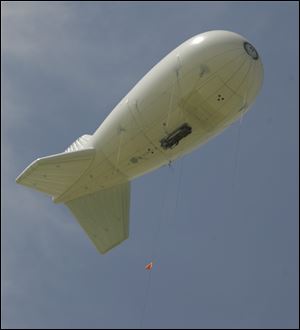
Blimp keeps eye on Lake Erie
8/2/2010
It's like a blimp, but it's unmanned and called an aerostat. The device, normally used for surveillance and communications, is tethered to a barge a half-mile from Maumee Bay State Park.
The blimplike device that hovered over western Lake Erie this time last year is back for another summer of surveillance.
Called an aerostat, the $125,000 research device is an unmanned military unit normally used for surveillance and communications.
Its mission is to track western Lake Erie's algae bloom. It is tethered to a barge that is anchored a half-mile from the shoreline of Maumee Bay State Park.
One of the primary benefactors of its work is Tom Bridgeman, an algae researcher at the University of Toledo's Lake Erie Center. Mr. Bridgeman, who has been tracking the algae in the lake's western basin since 2002, said he hopes later this summer to have the device gathering images from Michigan and other locales.
The aerostat is owned by the Army's Space & Missile Defense Battle Lab in Colorado. It is operated by a company called SkySentry, based in Colorado Springs, Colo.
Greg Maul, SkySentry's director of flight operations and a retired Air Force pilot, said the device is flown five to seven hours a day, weather permitting.
The flight times are designed to make maximum use of the high-noon sunlight, he said.
Images are transmitted to computers below. "It's like a nonblinking eye up there, hour after hour," Mr. Maul said.
It is capable of being flown as high as 3,200 feet above the water, although its height is restricted to 1,400 feet by Federal Aviation Administration regulations at the present site. It was flying at an altitude of about 700 feet on Friday, he said.
The aerostat also is helping to advance solar-power research at UT. It is equipped with solar panels that UT provided, Mr. Maul said.
It is 25,000 cubic feet in size, roughly the equivalent of a two-story house.
The aerostat was brought into this part of the Great Lakes region last summer at the request of U.S. Rep. Marcy Kaptur (D., Toledo), who is trying to assist scientists in their pursuit of solutions to the ongoing algae problem. Miss Kaptur obtained funding for the return visit, Mr. Maul said.
The device is being used by UT and the University of Cincinnati for a collaborative project that examines the viability of peering through the lake with remote-sensing technology from up in the air.
Doug Miller, SkySentry vice president, has said that research from this and other projects is being used to help advance the Army's development of a high-altitude surveillance vehicle that could gather information from as high as 65,000 feet.
That could result in a more portable military spy satellite. The military sees potential in that as a tool for aerial views of battlefields, for example, or to assist with relief efforts from disasters.